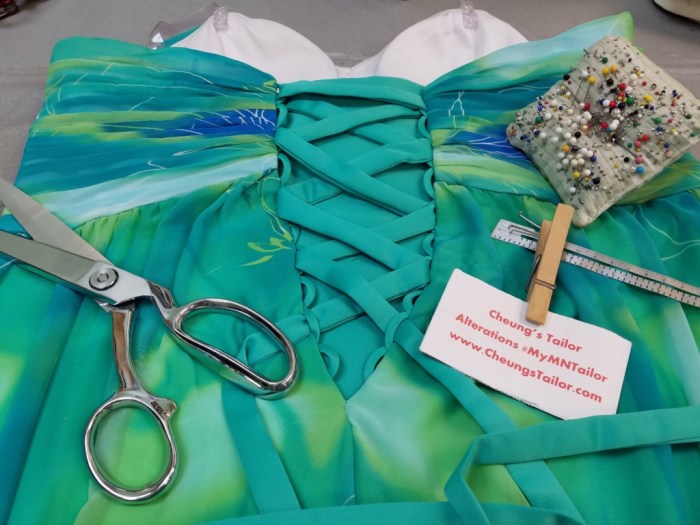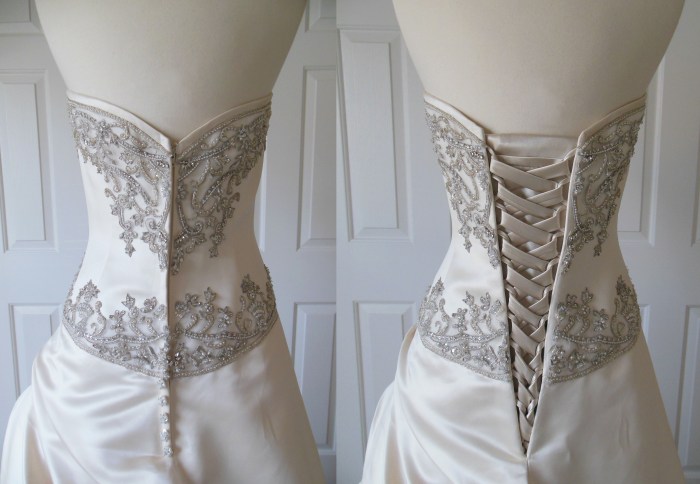
Types of Corset Backs for Wedding Dresses: Adding A Corset Back To Wedding Dress
Adding a corset back to wedding dress – Choosing the right corset back for a wedding dress significantly impacts both its aesthetic appeal and the wearer’s comfort. The three main types—laced-up, zippered, and hook-and-eye—each offer unique advantages and visual effects. Understanding their construction and suitability for different dress silhouettes is crucial for achieving the desired look and fit.
Laced-Up Corset Backs
A laced-up corset back offers exceptional adjustability and a visually striking detail. Construction involves using strong, flexible fabric such as coutil or a sturdy cotton blend, reinforced with boning (plastic or metal) for structure. Lacing is typically done with a high-quality satin or grosgrain ribbon. The laces are threaded through grommets or eyelets evenly spaced along the back panels.
This style creates a dramatic, romantic look, particularly effective on A-line and ballgown silhouettes, accentuating the waist and adding a touch of vintage charm. On a mermaid dress, the laced-up back adds a visually interesting counterpoint to the form-fitting skirt.
Zippered Corset Backs
A zippered corset back prioritizes ease of wear. It’s constructed similarly to the laced-up version, with boning for structure and a strong fabric base. However, instead of laces, a concealed or exposed zipper runs vertically down the center back. This style provides a clean, streamlined look, well-suited for modern or minimalist wedding dresses. The zipper offers quick and easy closure, making it a practical choice for any silhouette, including A-line, mermaid, and ballgown styles.
The visual impact is less dramatic than the laced-up back but provides a polished and sophisticated finish.
Hook-and-Eye Corset Backs
A hook-and-eye corset back offers a balance between adjustability and ease of use. Similar to the other styles, a strong fabric and boning structure is required. Multiple rows of hooks and eyes are sewn onto the corset panels, allowing for precise adjustments to the fit. This style can be quite discreet, especially when using small hooks and eyes, or it can be made more prominent with decorative elements.
It works well with various silhouettes, offering a subtle yet effective shaping effect. The visual impact is less dramatic than a laced-up back but provides a clean, refined look suitable for most wedding dress styles.
Comparison of Corset Back Styles
| Feature | Laced-Up | Zippered | Hook-and-Eye |
|---|---|---|---|
| Ease of Wear | Moderate | High | Moderate |
| Adjustability | High | Low | Moderate |
| Cost of Materials | Moderate | Low | Low |
Adding a Corset Back: Methods and Considerations
Adding a corset back to an existing wedding dress pattern or a finished garment requires careful planning and precise execution. Understanding the necessary pattern adjustments and sewing techniques is crucial for a successful outcome. Consider the fabric choice and potential fitting challenges beforehand.
Adding a Corset Back to a Pattern
To add a corset back to a pattern, you’ll need to create new pattern pieces for the corset itself. This involves drafting or tracing the existing back bodice pattern piece, then adding seam allowances and shaping the new pieces to create the desired corset structure. The pattern needs to incorporate allowances for boning channels and closures. Existing darts or shaping on the original back bodice might need to be adjusted or removed to accommodate the corset structure.
Sewing a Corset Back onto a Wedding Dress

Source: cheungstailor.com
- Prepare the corset back panels: Cut out the pattern pieces, ensuring accurate measurements and seam allowances.
- Attach boning channels: Sew channels into the corset panels to accommodate the boning.
- Insert boning: Carefully insert the boning into the channels, ensuring a smooth, even distribution.
- Attach the closure: Sew on the laces, zipper, or hooks and eyes according to the chosen style.
- Attach the corset back to the bodice: Sew the corset back to the existing bodice, ensuring a smooth and even fit.
- Finish seams: Finish all seams with appropriate techniques to prevent fraying and ensure a professional finish.
Challenges and Solutions
Adding a corset back can present challenges. Fabric choice is critical; a sturdy yet pliable fabric is essential to prevent puckering or stretching. Fitting issues may arise, particularly around the waist and shoulders. Careful fitting and adjustments are needed to ensure a comfortable and flattering fit. If significant alterations are needed, seeking professional help from a seamstress is advisable.
Design and Aesthetics of Corset Backs

Source: weddingbee.com
The design and embellishment of a corset back significantly contribute to the overall aesthetic of the wedding dress. Careful consideration of fabrics, decorative elements, and the overall style is essential to achieve a cohesive and visually appealing look.
Corset Back Embellishments, Adding a corset back to wedding dress
- Lace Appliqués: Delicate lace appliqués add a romantic touch, particularly effective on lighter-weight fabrics like silk or tulle. The lace can be hand-sewn or machine-sewn, and can be arranged in various patterns or layered for added texture.
- Beaded Embroidery: Intricate beaded embroidery creates a luxurious and glamorous look. This technique involves hand-sewing beads onto the fabric, often following a specific pattern or design. Various bead types, colors, and sizes can be used to achieve different effects.
- Crystal Detailing: Crystals add sparkle and shimmer, creating a dazzling effect. Crystals can be sewn individually or applied in clusters or patterns, using techniques similar to beading. The size and placement of crystals impact the overall visual effect.
Fabric Choices
Silk creates a luxurious and fluid drape, enhancing the elegance of a corset back. Satin offers a smooth, glossy finish with a more structured feel. Lace provides texture and visual interest, often used in conjunction with other embellishments. The choice of fabric affects the overall texture, drape, and visual impact of the corset back, influencing the overall aesthetic of the dress.
Aesthetic Styles
- Romantic: Soft pastel colors, delicate lace, and flowing fabrics like silk or tulle create a dreamy, ethereal look. Embellishments such as pearls or floral appliqués enhance the romantic feel.
- Modern: Clean lines, structured fabrics like satin or crepe, and minimalist embellishments define a modern aesthetic. A sleek, unadorned corset back can be incredibly chic and sophisticated.
- Vintage: Rich jewel tones, opulent fabrics like velvet or brocade, and antique-inspired embellishments such as intricate beading or embroidery evoke a vintage feel. A laced-up back perfectly complements this style.
Impact on Fit and Function

Source: emasscraft.org
Adding a corset back significantly impacts the fit, shaping, and overall functionality of a wedding dress. Understanding these effects is crucial for achieving the desired silhouette and ensuring the wearer’s comfort.
Impact on Fit and Shaping
A corset back enhances the silhouette by cinching the waist and providing support. It can create a more defined hourglass figure, enhancing the overall shape of the dress. The degree of shaping depends on the corset’s construction and the tightness of the lacing or closure.
Necessary Alterations
Adding a corset back may require alterations to other dress components to maintain a harmonious fit. This might involve adjustments to the shoulder straps, neckline, or skirt to ensure proper balance and prevent pulling or bunching. The alterations will depend on the specific design of the dress and the corset back.
Comfort and Ease of Movement
A well-constructed corset back can enhance comfort by providing support and shaping. However, if too tight, it can restrict movement and cause discomfort. Careful consideration of boning placement, fabric choice, and the tightness of the closure is crucial for ensuring comfort and ease of movement. Adjustments might be needed to ensure proper breathing room and ease of movement during the wedding day.
Key Questions Answered
Can I add a corset back to any wedding dress?
While most dresses can accommodate a corset back, the feasibility depends on the dress’s existing design and fabric. Some heavily structured or delicate fabrics might present challenges.
How much will adding a corset back cost?
The cost varies significantly based on the complexity of the corset, the materials used, and the seamstress’s labor rates. Expect a range from several hundred to several thousand dollars.
How long does it take to add a corset back?
The timeframe depends on the complexity and the seamstress’s workload, but it typically takes several days to a few weeks.
What if the corset back doesn’t fit perfectly after it’s sewn?
Minor adjustments can usually be made after the corset is attached. However, significant alterations might require removing and re-sewing parts of the corset.